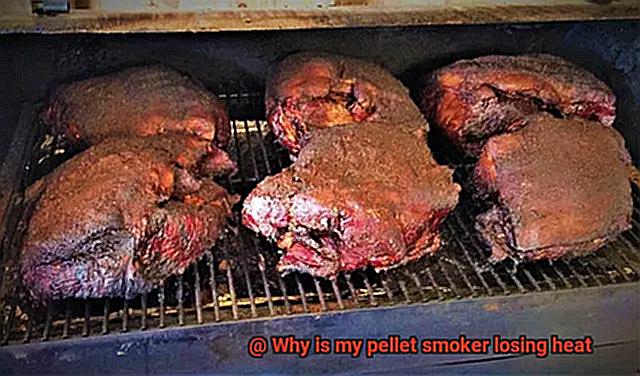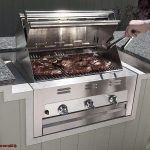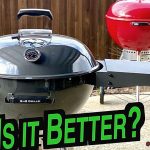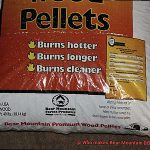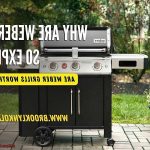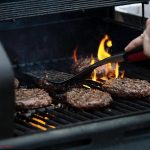Imagine this: it’s a beautiful summer day, and you’ve got your heart set on devouring the most succulent, perfectly smoked brisket.
- You’ve done everything right – seasoned your meat to perfection, set your pellet smoker to the ideal temperature – but now, you’re noticing that something’s off. Your smoker is losing heat, and your brisket is taking much longer than expected to cook.
- If you’re feeling frustrated and confused, don’t worry – you’re not alone. This issue is all too common among pellet smoker enthusiasts.
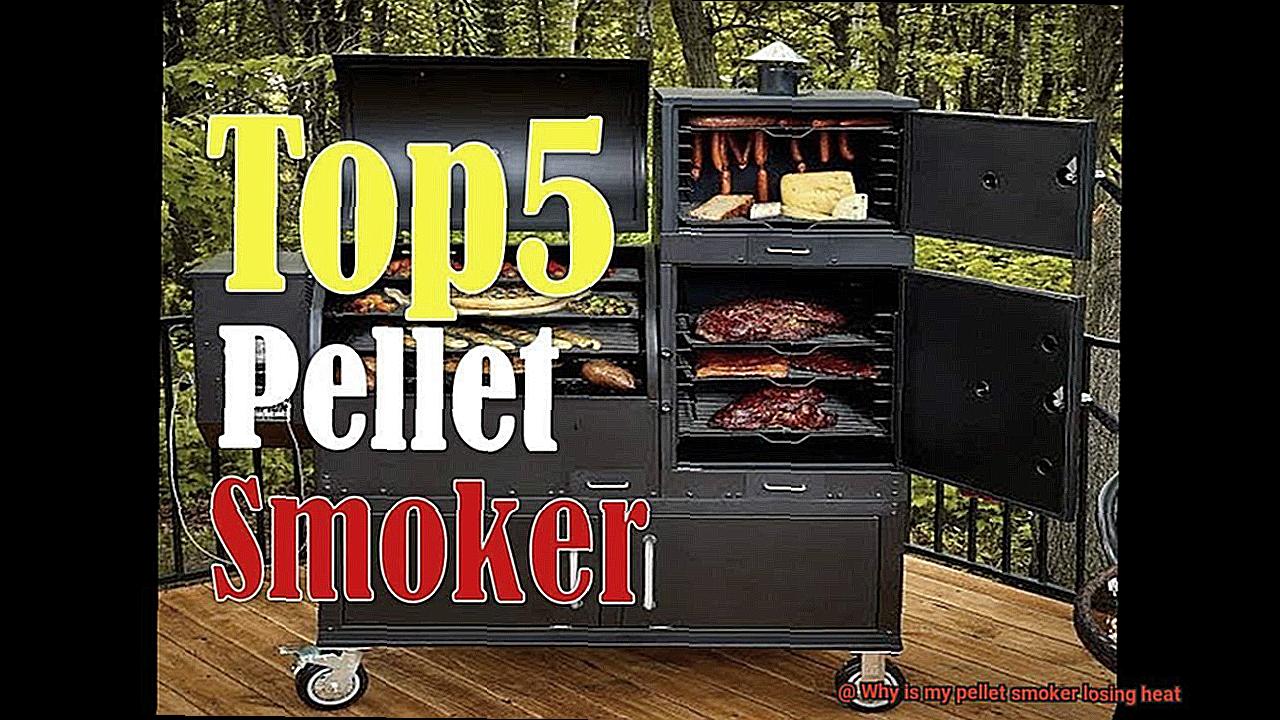
But fear not. In this blog post, we’ll explore some of the main reasons why your pellet smoker may be losing heat and how to fix it.
There are many factors that can cause your pellet smoker to lose heat. From poor maintenance practices to faulty components, there are numerous culprits that can negatively impact your smoker’s ability to maintain its desired temperature.
Keep reading to learn about the top reasons for heat loss and how to resolve them.
Contents
Reasons For Heat Loss in Pellet Smokers
However, hH
The first reason for heat loss in pellet smokers is poor insulation. Pellet smokers rely on a heating element to ignite wood pellets and maintain consistent heat. If the smoker’s walls are not properly insulated, the heat generated by the element can escape, resulting in a drop in temperature. This can be especially problematic in colder weather when outside temperatures can affect the smoker’s performance. So, it’s crucial to check the insulation of your smoker before starting to cook.
Another cause of heat loss in pellet smokers is low-quality pellets or pellets that have been exposed to moisture. These poor-quality pellets can cause the temperature to fluctuate and lead to heat loss. To prevent this issue, it’s essential to use high-quality pellets stored in a dry place.
Air leaks are another factor that can cause heat loss in pellet smokers. If there are gaps or cracks in the smoker, air can enter and exit, causing fluctuations in temperature. Regularly inspect your smoker and seal any gaps or cracks with high-temperature silicone or gaskets to prevent air leaks.
Furthermore, a dirty or clogged firepot can also contribute to heat loss in pellet smokers. If the firepot is filled with ash or debris, it can affect the air flow and cause the temperature to drop. Make sure to clean the firepot regularly and remove any ash or debris to ensure proper air flow and consistent heat output.
Finally, improper placement of the smoker can also lead to heat loss. If the smoker is located in an area with strong winds or is too close to a wall or other obstruction, the airflow around the smoker may be restricted, causing heat to escape and making it difficult for the smoker to maintain a consistent temperature.
In conclusion, several factors can contribute to heat loss in pellet smokers. Proper insulation, regular maintenance of temperature sensors and augers, and strategic placement of the smoker can all help prevent this issue and ensure that your grill performs at its best.
Lack of Fuel or Airflow
Well, there’s no need to worry. As an expert on the topic, I’m here to provide you with some valuable insights on how a lack of fuel or airflow can cause your pellet smoker to lose heat.
To begin with, let’s dive into the basics. Pellet smokers utilize wood pellets to cook your food; however, if there isn’t enough fuel getting to the fire, your smoker won’t generate enough heat to cook properly. This can occur due to a clogged hopper or a malfunctioning auger. Therefore, it’s essential to keep these components clean and functioning correctly for a steady flow of pellets to the fire.
But what if you’ve ensured that everything is in tip-top shape and your smoker is still losing heat? Well, the culprit could be wet or damp pellets. If the pellets were exposed to moisture or humidity, they won’t burn as efficiently as dry ones. It’s crucial to store them in a dry place and use them only when they’re entirely dry.
Now, let’s shift our focus towards airflow. Without proper airflow, the fire won’t receive enough oxygen to generate heat. A dirty or clogged air intake can prevent air from entering the smoker, causing poor airflow. Keeping your air intake clean and free from debris is vital for proper airflow.
Another crucial factor in proper airflow is the fan. The fan draws air into the smoker and distributes it evenly throughout the cooking chamber. If the fan malfunctions or stops working entirely, your smoker won’t maintain a consistent temperature.
Malfunctioning Components
Let’s explore the three main components that can cause temperature regulation issues: the auger, the fan, and the igniter.
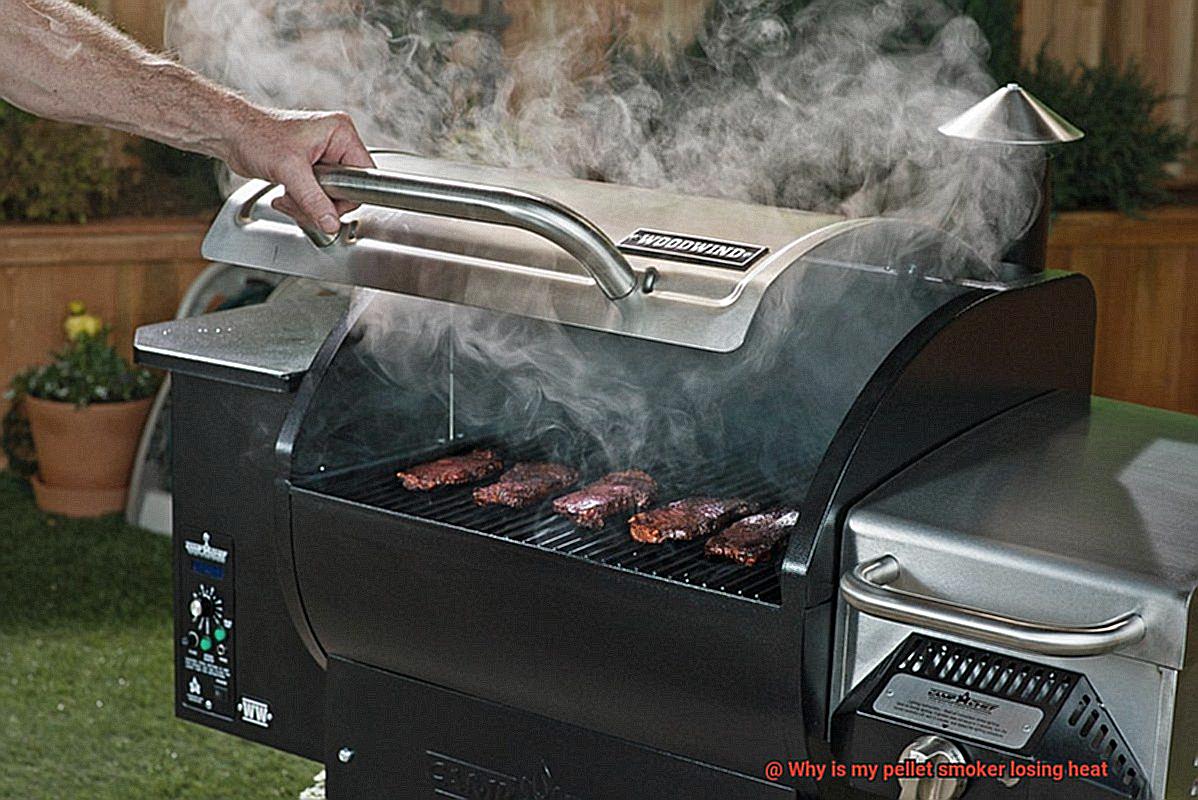
The auger is a vital component responsible for feeding pellets into the firepot to maintain a consistent temperature. If it malfunctions, you may notice your smoker struggling to heat up or stay at the desired temperature. Common issues with the auger include clogging or jamming, as well as a faulty motor. To keep your auger functioning optimally, clean it regularly and use high-quality pellets.
The fan is another essential component responsible for circulating air around the firepot to maintain a consistent temperature. If it fails to function correctly, you may notice your smoker struggling to stay at the right temperature or taking longer than usual to heat up. Common issues with the fan include a faulty motor or clogged blades. To keep your fan in top shape, clean it regularly and avoid using damp pellets.
Lastly, we have the igniter, which is responsible for lighting the pellets in the firepot to start the cooking process. If it malfunctions, you may notice your smoker not heating up at all or taking longer than usual to get started. Common issues with the igniter include faulty parts or a buildup of ash on it. To keep your igniter working perfectly, clean it regularly and replace any worn-out parts.
If you suspect any of these components are malfunctioning, take immediate action. In many cases, simple maintenance like cleaning or lubricating can solve the issue. However, if the problem persists, it may be time to replace the faulty part. Always consult your smoker’s user manual or contact a professional for assistance with component issues.
Troubleshooting Heat Loss Issues
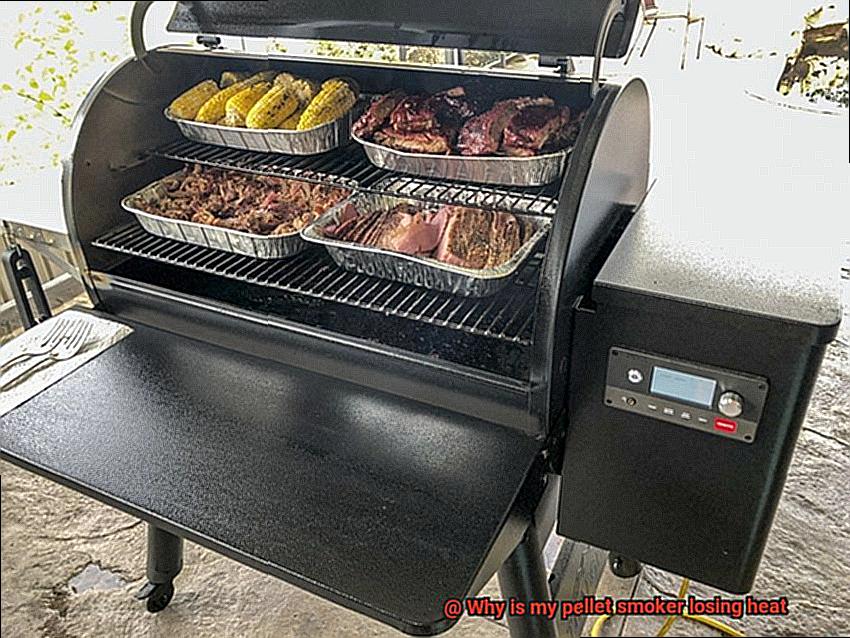
As a master in the field of troubleshooting heat loss issues with pellet smokers, I know that nothing is more frustrating than firing up your grill only to discover it’s not heating up properly. But don’t worry, my fellow grill enthusiasts, because I have a bag of tricks to help you diagnose and fix the problem.
Let’s start with the basics: ensure that your grill is properly plugged in and that there is power running to it. This may seem like a no-brainer, but sometimes a tripped circuit breaker or a loose power cord can cause heat loss. So before diving into more complex issues, make sure to check this first.
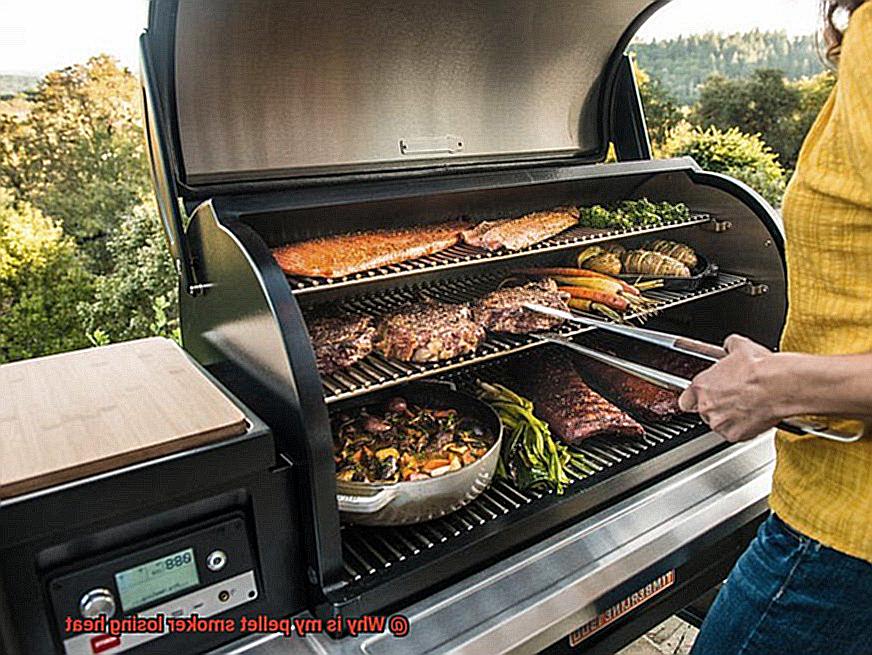
Next, check your hopper. If it’s low on pellets or empty altogether, this can cause your smoker to lose heat. Don’t skimp on quality pellets either as cheap ones can lead to inconsistent heat output and ultimately ruin your grilling experience. Make sure you’re using high-quality pellets that are designed for use in your specific smoker.
Assuming all is well with your hopper and pellets, the next thing to check is the firepot. Over time, ash and debris can accumulate in the firepot and clog up the airflow, resulting in decreased heat output. The simple solution? Clean out the firepot and any surrounding areas.
Finally, take a look at your temperature probe. If it’s giving inaccurate readings or malfunctioning altogether, this can also cause heat loss. To test the temperature probe, try using an alternate thermometer to compare readings and determine if the probe needs to be replaced.
Checking the Fuel Source and Airflow
When it comes to pellet smokers, losing heat can be a frustrating problem. But fear not, as an expert troubleshooter, I can tell you that checking the fuel source and airflow is the key to getting your smoker back up and running.
Let’s start with the fuel source – pellets. These little powerhouses are what keep your smoker going, but if they’re not feeding properly, your fire won’t burn hot enough to cook your food. A blocked hopper or auger can cause this issue. Without enough fuel, your smoker won’t be able to sustain a high temperature. So, make sure to check those first.
Now let’s talk about airflow. Proper airflow is essential in maintaining a consistent temperature in your smoker. Without it, heat won’t move around efficiently, causing your smoker to lose heat. To ensure proper airflow, check for any obstructions in the chimney or exhaust system. Creosote build-up can restrict airflow, so be sure to clean those areas regularly.
But wait, there’s more. Don’t forget about the air intake vents. These vents regulate how much air enters into the cooking chamber and play a vital role in regulating temperature. Blocked or closed vents will prevent your smoker from heating up properly. Keep them clean and unobstructed for optimal performance.
Inspecting Internal Components
Don’t worry, with a little bit of troubleshooting and some internal component inspections, we can get your smoker back up and running in no time.
Before we dive into the specifics of inspecting the internal components, let’s remind ourselves that proper fuel source and airflow are essential for optimal performance. Just like unclogging arteries to get the blood flowing, clearing out any obstructions in the chimney or air intake vents is crucial for your smoker’s health.
Now, if you’ve already checked the fuel source and airflow and your smoker is still not performing up to par, it’s time to take a closer look at the internal components. Let’s start with the fire pot – where the pellets are burned to create heat. If you’re not getting enough heat from this critical component, it may be due to a clogged or dirty fire pot. To inspect it properly, turn off the smoker and let it cool down completely. Then, remove any remaining pellets and ash from the fire pot using a brush or scraper.
Next on our checklist is the burn pot – where the pellets are ignited by the fire pot to produce heat and smoke. If it’s not working correctly, it may be due to a damaged or clogged burn pot. Take a quick peek inside for any debris or ash buildup in the burn pot and clean it out if necessary.
Moving along, we come across one of the most important parts – the auger. This little guy is responsible for feeding pellets into the burn pot continuously. If it’s not working properly, it may be due to an obstruction or malfunctioning motor. Check for any blockages in the auger tube and make sure it is correctly connected to the motor.
Last but not least, we have the fan – responsible for circulating air within the smoker to maintain consistent temperatures. If it’s not working correctly, it may be due to a malfunctioning motor or wiring issue. Check for any damage to the fan blades and ensure that it is properly connected to the motor.
External Factors Impacting Heat Loss
In addition to internal factors, external factors can also significantly impact heat loss in your smoker. Let’s dive into the key external factors you need to consider to ensure optimal performance and cooking results.
First up, the environment plays a critical role in heat loss. Wind, rain, and extreme temperatures can all wreak havoc on your smoker’s ability to maintain an even temperature. Grilling in a windy location can cause heat to dissipate rapidly, leaving you with a cold smoker and undercooked food. Similarly, high humidity levels during a rainy day or near coastal areas can make it challenging for your smoker to maintain a consistent temperature. Keep an eye on the weather forecast and make necessary adjustments to ensure optimal performance.
Next on our list is insulation quality. Even if you have the best fuel and perfect cooking conditions, poor insulation or air leaks can cause significant heat loss, making it challenging to achieve your desired temperature. Regularly inspect your smoker for any gaps or leaks in the seals and ensure that all vents and dampers are functioning correctly.
Last but certainly not least, fuel type is another crucial external factor that can impact heat loss. Different types of wood pellets have varying burn rates and heat outputs. Using lower quality pellets with a lower BTU output can lead to quick heat loss, making it difficult to maintain an even temperature. Always choose high-quality pellets designed for use in pellet smokers to achieve optimal performance and temperature control.
Cold Weather Conditions and Windy Days
You know that cold weather conditions and windy days can be a real challenge when it comes to maintaining consistent temperatures and achieving delicious results. But don’t worry, there are solutions to help you overcome these obstacles and take your smoking game to the next level.
Firstly, let’s talk about pellets. Using high-quality pellets designed for cold weather conditions is crucial. These pellets contain less moisture and burn hotter, making them more effective in colder temperatures. So before you start smoking on a chilly day, make sure you have the right fuel for the job.
In addition to choosing the right pellets, insulation is key. A thermal blanket or insulation cover can help trap in heat and prevent it from being lost to the surrounding environment. This is especially important when temperatures drop below freezing. You don’t want to be waiting for your smoker to reach the right temperature while your guests are getting hangry. Additionally, placing your smoker in a sheltered area out of the wind can also help maintain consistent temperatures.
But that’s not all. Regular maintenance is crucial to ensure optimal performance. Blockages or buildup in your hopper or auger can cause heat loss, affecting performance and ruining your smoking experience. So make sure to give these components a thorough cleaning before each use.
Professional Assistance and Contacting the Manufacturer
If you’re facing a frustrating situation of dealing with a pellet smoker that’s losing heat, don’t worry, you’re not alone. When all your attempts to fix the issue have failed, it’s time to call in the professionals. The manufacturer of your pellet smoker is your best bet for professional assistance when it comes to troubleshooting and repair.
Most manufacturers have a customer service hotline or email address that you can contact for help. They may have a team of experts who can guide you through the process of identifying the problem and fixing it. In fact, some manufacturers may even offer to send a technician to your home to take a closer look at your pellet smoker.
When contacting the manufacturer, make sure you have your model and serial number ready. This will help them identify your specific pellet smoker and provide tailored assistance. Also, be prepared to describe the issue in detail, including any steps you’ve taken to try and fix it. The more information you provide, the better equipped they’ll be to help you out.
Apart from troubleshooting and repair, manufacturers can also offer valuable advice on maintenance and cleaning. They may have specific recommendations for how often you should clean your pellet smoker and which products to use. Following their advice will extend the life of your grill and keep it performing at its best.
So, don’t hesitate to reach out to the manufacturer when you’re experiencing issues with your pellet smoker. They have the expertise and knowledge to help you get your grill back up and running in no time. Here are some quick tips for contacting the manufacturer:
- Have your model and serial number handy
- Describe the issue in detail
- Listen carefully to their advice on maintenance and cleaning
- Consider taking advantage of any technician services they offer
GXXeqKJa-YA” >
Conclusion
To sum it up, a pellet smoker losing heat can be a frustrating setback for any grilling enthusiast.
The good news is that there are various reasons why this may happen, and even better news is that there are solutions to the problem. Whether it’s poor insulation or malfunctioning components, you need to take a systematic approach to troubleshoot the issue.
Check your fuel source and airflow, inspect internal components like the fire pot, burn pot, auger, and fan, and consider external factors like insulation quality and fuel type. Don’t forget to clean the firepot and air intake vents regularly to prevent heat loss.
They can guide you through troubleshooting steps or send a technician to your home for repairs.

